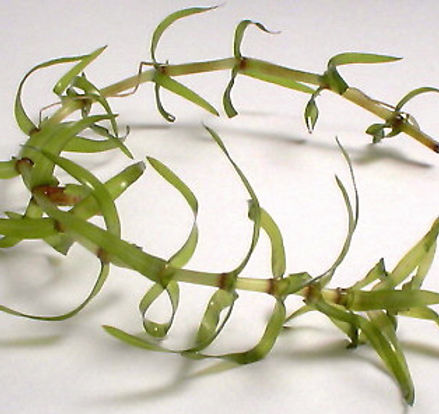

Ireland: Kerry - Dublin - Cork - Waterford - Roscommon - Galway - Belfast
UK: London - Manchester - Newcastle - Cardiff - Liverpool
Canadian Waterweed
Invasive Species Information

What Is Canadian Waterweed - (Elodea canadensis)?
Habitat: Aquatic, freshwater
Distribution in Ireland:
Status: Established
Family name: Hydrocharitaceae
Common name/s: Canadian pond weed
Reproduction: Canadian waterweed is dioecious, with male and female flowers on different plants. Flowers from May to October.

Canadian Waterweed leaves

Canadian Waterweed leaf
Young plants initially start with a seedling stem with roots growing in mud at the bottom of the water; further roots are produced at intervals along the stem, which may hang free in the water or anchor into the bottom.
It grows indefinitely at the stem tips, and single specimens may reach lengths of 3 m or more.
It lives entirely underwater, the only exception being the small white or pale purple flowers which float at the surface and are attached to the plant by delicate stalks.
Canadian waterweed is closely related to Elodea nuttallii, which generally has narrower leaves under 2 mm broad. It is usually fairly easy to distinguish from its relatives, like the Brazilian Egeria densa and Hydrilla verticillata.
These all have leaves in whorls around the stem; however, Elodea usually has three leaves per whorl, whereas Egeria and Hydrilla usually have four or more leaves per whorl. Egeria densa is also a larger, bushier plant with longer leaves.
How To Identify Canadian Waterweed?

Canadian Waterweed - Elodea canadensis ID Guide
Leaf: bright green, translucent, oblong, 6–17 mm long and 1–4 mm broad, in whorls of three (rarely two or four) round the stem.
Flower: three small pinkish/white petals; male flowers have 4.5–5 mm petals and nine stamens, female flowers have 2–3 mm petals and three fused carpels
Stem: Fleahy, light green/transucent with relish brown nodes at leaf join
Seed: seeds are 4–5 mm long, fusiform, round, and narrowly cylindrical
Fruit: Fruit is an ovoid capsule, about 6 mm long containing several seeds that ripen underwater.
Canadian Waterweed flower
Canadian Waterweed


Why Is Canadian Waterweed A Problem?
Canadian Waterweed is an alien (non-native) invasive plant, meaning it out-competes crowds-out and displaces beneficial native plants that have been naturally growing in Ireland for centuries.
Grows rapidly in favorable conditions and can choke shallow ponds, canals, and the margins of some slow-flowing rivers.
This web page is currently under development - we have an anticipated update for early November 2017.
Sign up for our free monthly news letter and get regular updates, information and resources to help you identify and manage alien invasive species on you property.
We apologise for any inconvenience. Please try again later.
European Communities (Birds and Natural Habitats) Regulations 2011 non-native invasive plant species A-Z (Updated 2017)
There are currently 35 invasive plant species listed in the European Communities (Birds and Natural Habitats) Regulations (annex 2, Part 1)...
Click on a species from the following list to find out more regarding non-native species subject to restrictions under Regulations 49 and 50.
-
American Skunk-Cabbage - Lysichiton americanus
-
Red Alga - Grateloupia doryphora
-
Wakame - Undaria pinnatifida
-
Waterweeds - Elodea (all species)
Non-Native Plant Species identified as High Risk on Ireland's Biodiversity List...
Common name
Species name
Environment
Terrestrial
Freshwater
Terrestrial
Terrestrial
Marine
Freshwater
Freshwater
Freshwater
Terrestrial
Terrestrial
Terrestrial
Terrestrial
Marine
Terrestrial
Freshwater
Freshwater
Freshwater
Terrestrial
Freshwater
Marine
Risk score
20
19
18
19
18
19
21
20
19
18
18
19
19
20
20
19
20
20
20
18

